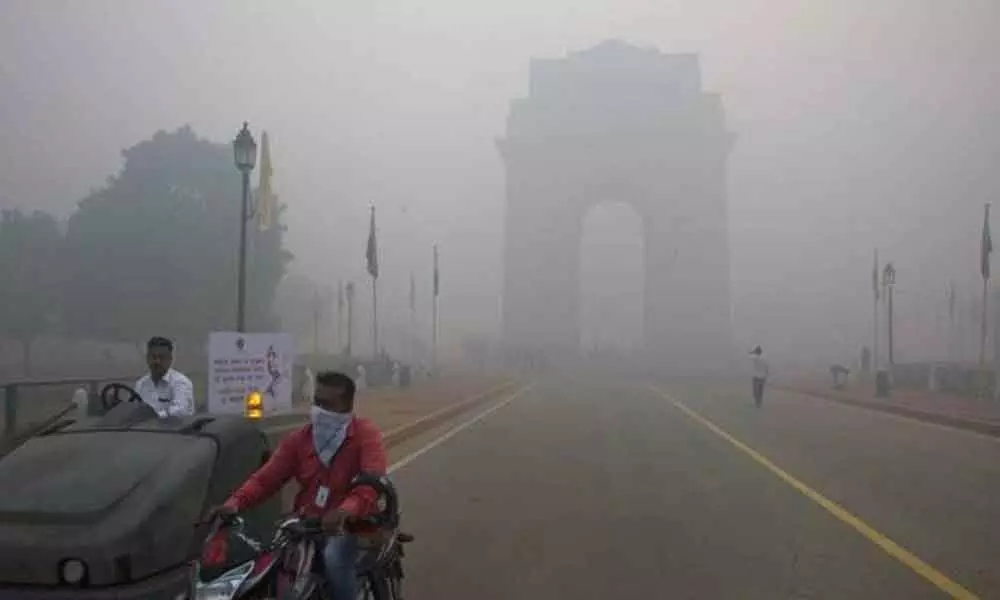Live
- Tender to be called for new gates to TB dam in January
- TTD EO inspects Tiruchanoor Brahmotsavam arrangements
- Crisis grips Davanagere farmers despite bumper crop
- NSU probes drug use incident
- Yathindra Siddaramaiah’s statement on judiciary sparks petition for contempt of court
- Initiate steps for implementation of GER: Minister Anam
- Mammootty and Mohanlal to Team Up for Their 50th Film Together
- CAG points out increasing debts during 2022-23
- Youth Commits Suicide in Srikalahasti
- MeT department advises TN fishermen to avoid deep sea fishing
Just In

The national capital's air quality remained "severe" for the fifth consecutive day on Monday, with calm wind speed exacerbating the effect of stubble burning.
The neighbouring cities of Faridabad (462), Ghaziabad (483), Noida (476), Greater Noida (482), and Gurugram (475) also recorded "severe" air quality.
New Delhi: The national capital's air quality remained "severe" for the fifth consecutive day on Monday, with calm wind speed exacerbating the effect of stubble burning.
The city's air quality index (AQI) stood at 469 at 9 am. Its 24-hour average AQI was 416 on Sunday, 427 on Saturday, 406 on Friday and 450 on Thursday, the highest since November 15 last year, when it was 458.
The neighbouring cities of Faridabad (462), Ghaziabad (483), Noida (476), Greater Noida (482), and Gurugram (475) also recorded "severe" air quality.
An AQI between zero and 50 is considered "good", 51 and 100 "satisfactory", 101 and 200 "moderate", 201 and 300 "poor", 301 and 400 "very poor", and 401 and 500 "severe".
PM10 levels in Delhi-NCR stood at 575 microgram per cubic meter at 9 am, the highest since November 15 last year, when it was 637 microgram per cubic meter, according to CPCB data. PM10 levels below 100 microgram per cubic meter are considered safe in India.
PM10 is particulate matter with a diameter of 10 micrometers and is inhalable into the lungs. These particles include dust, pollen and mold spores.
The levels of PM2.5 - finer particles which can even enter the bloodstream - were 366 microgram per cubic meter at 9 am. PM2.5 levels up to 60 microgram per cubic meter are considered safe.
According to the India Meteorological Department (IMD), the wind speed was 3 to 4 kilometres per hour in the morning and the minimum temperature 10 degrees Celsius. Calm winds and low temperatures trap pollutants close to the ground, while favourable wind speed helps in their dispersion.
The central government's Air Quality Early Warning System for Delhi said a "significant improvement in air quality is not likely" owing to slow wind speed, particularly during night time, and contribution from farm fires.
"The farm fire count over Punjab remains very high which is likely to impact the air quality of Delhi-NCR and other parts of northwest India," it said.
The Ministry of Earth Sciences' air quality monitor, SAFAR, said surface winds have become calm and are predicted to remain so for the next two days.
"This is a major factor due to which no quick recovery is expected unless a drastic reduction in fire counts takes place," it said.
SAFAR said the share of stubble burning in Delhi's PM2.5 pollution was 29 percent on Sunday.
It was 42 percent on Thursday, the maximum this season so far.
Last year, the stubble contribution to Delhi's pollution had peaked to 44 percent on November 1, according to SAFAR data.

© 2024 Hyderabad Media House Limited/The Hans India. All rights reserved. Powered by hocalwire.com







